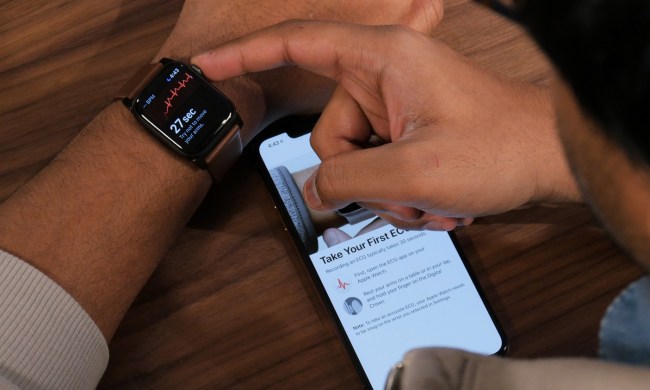Named for its silvery and blue stripes, the zebrafish is a freshwater member of the minnow family. The stripes run horizontally along their 2-inch bodies. Though they have scales and tails and their eyes protrude from the size of their heads, the fish are genetically similar to humans. Similar enough that Randall Peterson has rows and rows of plastic tubs full of them in his laboratory at the University of Utah.
“We take a somewhat unusual approach to discovering new drugs,” Peterson, dean of the university’s college of pharmacy, told Digital Trends. “Eighty-two percent of disease-causing genes in humans have an analogous gene in zebrafish.” Researchers in his lab manipulate the zebrafish’s genes to mimic human diseases, then attempt to treat them by dosing them with chemical compounds. The ones that work are potential future drug candidates. Peterson’s lab is mainly focused on Mendelian disorders, ones where mutations in a single gene causes a disease, as with cystic fibrosis.
Genetic testing required
Cystic fibrosis is often cited as an example of how precision medicine can make drugs more effective for patients. A drug called ivacaftor helps treat (but not cure) the underlying cause of the disease, instead of just managing symptoms. Ivacaftor is one of a handful of drugs the Food and Drug Administration requires genetic testing for before a doctor can administer for it. That’s because only about 5 percent of people with cystic fibrosis have the mutation the drug targets. It’s a fact critics have pointed out about precision medicine: It’s costly (ivacaftor costs over $300,000 a year) and the patient population is narrow. However, studies have recently show some promising results with ivacaftor in combination with other drugs, even for those without the specific mutation.
“We know that some of the information that comes out of genetics can be both challenging to understand sometimes and, frankly, scary to some extent.”
In some cases, precision medicine can be a treatment in search of patients. In November, the FDA approved a cancer treatment with a shared mutation, regardless of the tumors’ location in the body. Somewhere between 2,000 and 3,000 patients per year have a cancer related to this mutation. Genetic tumor testing is common in academic institutions but isn’t universal in all treatment centers. Yet one benefit of testing tumors can reveal which mutations won’t respond to certain treatments. A recent study found that women with a common type of breast cancer can forgo chemotherapy, as it offered no more benefit than hormone therapy alone.
Personalized medicine research is subject to some problems, according to statistician Stephen Senn. In an article for Nature, he wrote that many precision medicine studies categorized patients as responders and non-responders without taking into account that perhaps that result was simply true for that day. Studies should test participants with the same treatment multiple times, he said.
The 0.1 percent
As genetic testing becomes more common, researchers are finding information about diseases they weren’t even necessarily looking for. Expand the population of people who get their DNA sequenced or genotyped to those that are healthy, and it starts to change how doctors look at certain mutations. Lynch syndrome, a hereditary disorder that increases the risk of colon, ovarian, and other cancers, is one example. Some mutations have high penetrance, and over 60 percent of those with that variant will develop cancer. Other mutations are less straightforward.
“A whole lot of those fly under the radar,” said Dr. Deborah Neklason, a research associate professor in the Department of Oncological Sciences at the University of Utah School of Medicine. If they don’t have colon or endometrial cancer, they don’t have tumors to test. But understanding why these gene variants are less penetrant could lead to treatments for those who do get sick. “If we can understand the biology maybe we can go at treatment more effectively,” Neklason said.
Getting there won’t be fast, cheap, or easy. One important step is bolstering the genetic information that’s already available. While all humans are on average 99.9 percent identical, in that remaining 0.1 percent you’ll have more genetic markers in common with your sister than your co-worker. That might mean she’ll be more likely to be able to donate an organ to you and have it be a match, but the key to not getting a disease in the first place might lie in your unrelated co-worker’s DNA. A study suggests women of Indigenous American ancestry who have a certain genetic variant are at a lower risk of developing breast cancer, for example. Research based on that population could potentially lead to a treatment for women without that variant, but there’s a problem. The majority of participants in genetic studies, around 80 percent, are of European descent. Very few people with indigenous ancestry have had their DNA studied for research purposes.
In search of a million
A project called All of Us hopes to change that. Originally part of former President Barack Obama’s 2015 Precision Medicine Initiative, the program launched earlier this year. It will collect a variety of information, including genetic, from at least a million people of diverse ages, ethnicities, and economic backgrounds. Volunteers may be asked to fill out health surveys, share their medical records, provide blood and urine samples, and wear fitness trackers. In addition to getting more diverse DNA samples, researchers hope to follow participants for at least decade to learn more about their lifestyles. One challenge for biobanks like these is balancing the privacy of those who donate DNA with the need to share the information with research partners.
Critics have cited the cost and potential difficulties recruiting volunteers for a project of this scope. Databases of genetic and health information already exist, such as the Million Veteran Program, but 92 percent of its participants are men. “You’re not going to do a good ovarian cancer study with it,” one researcher said of the data.
One million participants might not sound like a lot if you’re comparing it with the number of customers who have signed up for services such as 23andMe. Direct-to-consumer tests use genotyping instead of sequencing to analyze DNA. It’s a less expensive and comprehensive method that narrows the focus to known variants, while sequencing can turn up unique variants researchers weren’t necessarily looking for. When 23andMe delivers users’ reports, it’s careful to state that the results don’t reveal whether or not they have a certain disease. While the company has tests for the BRCA1 and BRCA2 genes associated with breast cancer, it only includes three variants, ones are which most common in people of Ashkenazi Jewish descent. It’s one reason Neklason thinks these types of tests are best for recreation purposes only.
“There’s so much more of disease that’s caused by your environment than your genetics for the average person.”
“People come out of [getting their results] thinking that they’ve got yes no answers for everything, and it’s definitely not true,” Neklason said. “There’s so much more of disease that’s caused by your environment than your genetics for the average person.”
Many companies, such as pharmaceutical giant GlaxoSmithKline, are still eager to partner with 23andMe. It will have access to anonymized data that will help them create targeted drugs. In addition, the company will be able to contact, for example, Parkinson’s patients with a particular gene variant who have given their consent. This saves GlaxoSmithKline from having to test patients in order to find ones with that version of the gene.
Determining dosage
23andMe clearly wants to tell users more about their health than what type of ear wax they have. Recently, the FDA approved it as the first consumer DNA test for pharmacogenetics (PGx). The company will be able to deliver reports to users about how their genes may affect the way they process certain medications, such as blood thinners or antidepressants. Because of the FDA’s warnings, users will be cautioned that they shouldn’t use the report as medical advice. They shouldn’t suddenly double up on ibuprofen without talking to a doctor, for example.
Yet your internist may not be prepared to change your dosage, even if you hand them your report. First, they’d have you get tested by an independent lab. Even then, your doctor may still be cautious. Pharmacogenetics is an emerging field. There are over 200 drugs with pharmacogenomic information on their labeling, but a recent study found that between 2011 and 2013, only 1.5 percent of medications that recommended or required genetic testing were actually accompanied by testing. For some drugs, the FDA requires testing because patients’ with certain variants can develop serious side effects. For example, an anti-seizure medicine, carbamazepine, can cause severe skin reactions in those with certain genetic variants. The Clinical Pharmacogenetics Implementation Consortium (CPIC) is attempting to create guidelines to help physicians better understand how to use results of genetic testing when prescribing dosing.

Tailoring dosing to a person’s genes injects complexity into the process, which is already dependent on factors such as body mass, age, and microbiome. Whether or not a patient has eaten before taking a pill can even affect how long it takes to absorb. “Oftentimes the early stages of establishing a prescription involve some experimentation with dosing,” said Scott Topper, head of clinical operations at Color Genomics. Instead of doing so with a drug like warfarin, an anticoagulant, doctors can avoid some negative reactions by dosing based on the genes that code for the enzyme that metabolizes the medication.
For $249, Color will analyze your saliva for some hereditary cancers and high cholesterol, as well as 14 genes that affect how you metabolize certain medications. Two of the genes are thought to impact how the body processes antidepressants such as Zoloft and Paxil. Critics say researchers haven’t studied this area of PGx as much as others and adjusting these medications based on genes may not have the same impact as something such as warfarin. Topper said Color still believes there’s a place for genetics: “What our hope is, and what our expectation is, is that pharmacogenomics become one of those factors that’s considered in that process of the physician establishing the correct dose for their patients.”
When a user receives their report from Color, they have the option of speaking with a genetic counselor. “We know that some of the information that comes out of genetics can have a very precise meaning and can be both challenging to understand sometimes and, frankly, scary to some extent,” Topper said. The tests aren’t a crystal ball. Some genetic markers make people more susceptible to certain cancers but having a certain variant doesn’t mean you 100 percent will or won’t get breast cancer. Many diseases are the result of a combination of genes plus environmental factors. Genetic counselors are trained to explain test results and discuss treatment or prevention options. “There is a huge technical, clinical aspect to this and there’s also an emotional aspect to this as well,” said Topper.
The genetic marketplace
The Mayo Clinic Gene Guide is another health-centric test. It includes some information about disease risk for age-related macular degeneration, atrial fibrillation, and coronary artery disease, as well as PGx information about ibuprofen and omeprazole (for heartburn) metabolism. A physician from PWN Health reviews each test result and will reach out to the user before returning the results if they find a variant that could put them at higher risk for certain conditions.
“Malignant hyperthermia is one of those high-impact results where we want to make sure that they understand what positivity for that disorder — or for that for that lack of ability to metabolize certain inhaled anesthetics — what that means for them,” said Matthew Ferber, a Mayo Clinic genomics researcher. “And so that’s the case where PWN Health will get involved proactively to talk with them.” The physician would communicate to the user that they should discuss the result with their own healthcare provider, because they’re at increased risk for negative reactions to some inhaled anesthetics. “That’s a lot for somebody to understand with just having a standalone positive result, which is why we have PWN Health reaching out to those individuals,” Ferber said.
“If you’re a general person walking the street and don’t have thousands of dollars to spend, I think that a consumer product can be very informative.”
He stresses that the Mayo Clinic Gene Guide and similar tests aren’t for diagnostic purposes. “When you’re sick and you’re trying to find a diagnosis, you follow a more ‘leave no stone unturned pathway,’” Ferber said. “But if you’re a general person walking the street and you really just want to know, ‘Am I at a higher risk for X, Y, or Z, and I don’t have thousands of dollars to spend,’ I think that a consumer product can be very informative.”
The Mayo Clinic Gene Guide is part of Helix, which has created a marketplace for genetic information. Different companies can, with your permission (and payment), access your sample and tell you about your wine preferences, ancestry, or food sensitivities.
While the information you glean from these results probably won’t change your world, you might want to consider what you’re giving to those handling your DNA. There aren’t many regulations dictating how these companies can use your genetic information. Some have agreed to follow industry-created rules, but they can be pretty secretive about how they come to their conclusions. Many people looking for a cure for a disease that’s struck their family are more than willing to give away their DNA for research purposes. The same might not be true of the search for a more palatable beverage. DNA isn’t always destiny, but it’s a decent chunk of who you are.


